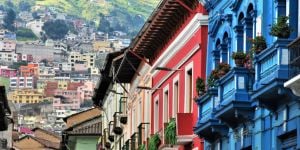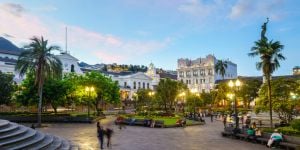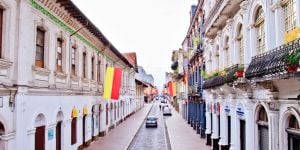BOTTLED GAS IN ECUADOR
russelleaton wrote:When you take into account the government subsidy, the cost of electricity for the induction cooker will only be marginally higher that the equivalent gas cooker. When the government subsidy runs out after about 3 years, existing gas subsidies will also be withdrawn, thus pushing up gas prices.
I only know two people that have switched to electric cook stoves. Both people states their electricity costs skyrocketed, far past the projected cost of propane after the subsidy is removed (expected $25/tank instead of $2.58).
In our case, we use propane for water heater and cooking. There are no good electric colofons (that I am aware of), so we would still have gas even if we converted cooking. We have 5 tanks in a separate room, all hooked in parallel to a single feed. We have to replace them about once every 6 weeks or so.
I understand the ecological reason for converting. However, almost everyone will do what is in their own personal interest and, particularly in a very poor country like Ecuador, that means the cheapest in most cases. The government has invested heavily in renewable electrical sources. They need to drastically cut the cost of electricity if they are going to be successful in any voluntary mass conversion from gas to electricity cooking.
russelleaton wrote:...Using gas is a real hassle because of the need to manage the gas tanks...Russell
Uh...not really
Please tell us, Russell, whom to contact and how, to take advantage of the government's conversion promotions.
Do you know a website where this is officially explained?
cccmedia in Quito
mindstorm,
If the friends electric bill jumped to $100.00, there is clearly something wrong.
I have a family of 4, two of which are teenagers, our bill hovers around $45.00. I added the proper grounds and breakers to use a four element electric range. We use it as a primary means to cook daily, we still have and will keep the gas oven and range for when the power goes out.
What people need to understand is that this transition will not be immediate. There is a considerable amount of work to be done which will be very expensive to update the cities electrical grid to support it. Having a secondary source (gas) available is not only smart but will be needed as this conversion happens. There will be many power outages as this happens. Also there is no way to know just how long it will take, once they actually begin. Right now several programs have been dropped due to petroleum prices, which has affected the countries budget.
Most homes I have seen as well as new construction homes have one, sometimes two 220 VAC knife switches installed. So long as they are not tied into a lighting circuit there is no issue. If so you will know, when your dryer is on and you turn on the T.V. the breaker will trip.
The best official place to start is at: http://www.cocinasdeinduccion.gob.ec/
But as mentioned, remember that to qualify you need an Ecuadorian cedula and you need to be already using a gas cooker where you live.
Russell
russelleaton wrote:The best official place to start is at: http://www.cocinasdeinduccion.gob.ec/
But as mentioned, remember that to qualify you need an Ecuadorian cedula and you need to be already using a gas cooker where you live.
Actually, that web site says that either a cedula or passport is required ID, so it looks like you don't even need a resident visa?
However, it also says "obtain the tariff incentive of up to 80 kWh / month for induction cooker." I used 88 kWh last month, even without an induction cooker. And yes, my electric bill was $136 for the month. I can see where adding an induction cooker could easily send a bill past $100, even with the tariff incentive...
In order to change, the bill must be in the name of the person who owns the house.
Susan F. wrote:In order to change, the bill must be in the name of the person who owns the house.
I know several people that own property here in Cuenca but do not have (nor intend to get) residence visas. For them, I guess their passport would allow them to get the discount. They come here 90 days per year, and rent out their place when they are not in Ecuador.
mindstorm,
Do you live in a single family home or an apartment building?
If in an apartment, does each unit have its own meter or a common one for all? Something does not sound right. Last month with a family of (4) four, we used 29 kwh and our bill was $44.47. 
I used 88 kWh last month, even without an induction cooker. And yes, my electric bill was $136 for the month.
Last month with a family of (4) four, we used 29 kwh and our bill was $44.47.
Both of these work out to over $1.50 per kWh for the cost of electricity in Ecuador - surely that can't be right?
In the US overall average and where I am, electricity costs about $0.10 per kWh. In Colombia it's about the same as the US.
GMC(SW) wrote:mindstorm,
Do you live in a single family home or an apartment building?
If in an apartment, does each unit have its own meter or a common one for all? Something does not sound right. Last month with a family of (4) four, we used 29 kwh and our bill was $44.47.
We are in a large (4 bedroom, 3 bath) apartment with separate metering. We had a long discussion on the size of my electric bill over on the Facebook Ecuador Expats forum a couple weeks ago. I put meters on my computer system (costs $45/mo all by itself), and my electric foot heater by my desk (was cold last month, and I calculated cost $30 for the month to keep my desk area warm).
That bill also includes $30 for garbage collection.
Thanks for pointing this out because the rates were making me scratch my head. My thinking was that perhaps they calculate it differently in Ecuador. I used the rates posted and my son's gaming computer would cost $60 a month alone in electricity costs and that's just astronomical.
So I did a little reading and this is what I found:
Dignity rate is .04 kWh ( for households that consume less than 110 kWh per month)
The rate is .0933 kWh for households that use more than 110 kWh
kWh and prices coated :
150 kWh = ~$12
300 kWh = ~$24.81
500 kWh = ~$42
source: http://www.elcomercio.com/actualidad/ne … busca.html
(I translated to English)
BTW, here is a screenshot of the relevant part of my electrical bill
Hi Mindstorm and thanks for posting you bill.
Your bill states you consumed 789 kWH and was charged $88.31 or about .11 per kWH. That helps explain matters as paying $136-30 for 88 kWH would have suggested that something was wrong.
My electric bill for my all-electricity apartment in Quito runs about ten dollars a month. That includes plenty of computer use, an automatic dishwasher and the other usual stuff. Hardly need to use the space heaters anymore.
My condo fee is $29 per month, which covers 24-hour security, community-areas maintenance and incoming-mail service.
cccmedia in Quito
Ok,
That makes a little more sense.
Well, apart from the obvious one that 220V is double 110V, in practical terms it means that you can transmit twice the power (not current) through a 220V cable, as you can through a 110V cable, provided that the cables are the same thickness.
Basically, it is an economic issue.
The current (Amps) determines the diameter of the copper cable.
The more current required, the thicker (and heavier) the cable must be.
Because P=V x A (Power = Volts x Amps), a country using 220V service requires copper cable of only 1/2 the volumetric diameter to deliver the same amount of power to all its consumers, as compared to a country which has 110V service.
On a 220V line, you are drawing only 1/2 the Current (amps) to achieve the same power delivery, as compared to a line running 110V.
The USA, as a rich country, could afford to install an electrical infrastructure of thick and heavy copper cables, with a lower and safer 110V voltage, whereas the rest of the world took the cheaper option of thinner and lighter cables at 220V to achieve the same power (Watts) delivery.
That's why an electric clothes dryer and other powerful devices like central heating or big window air conditioners have to have a 220 volt supply; for the same cable thickness, you can draw twice the power (watts) as compared to a 110V line.
Your electric bill is based on kilowatt hours.
A kilowatt hour (KWh) cost the same regardless of voltage so there is no difference in cost between 110 VAC or 220 VAC.
The reason for the two voltages is that some appliances, such as your stove, dryer, water heater, draw a lot of power.
A water heater is typically 4400 watts.
At 110 volts this would be 40 amps.
That would take a big wire.
At 220 volts, 4400 watts only takes 20 amps.
You don't need as big a wire for the same power.
The lower current is also a little safer as the potential heating in the wiring is reduced.
This is also why most 110 VAC appliances are limited to about 1200 to 1500 watts.
1200 watts on a 110 VAC circuit is just under 11 amps.
1500 watts is just over 13.5 amps.
Most houses have 20 amp circuit breakers but older houses may have 15 amp breakers or fuses.
You want some headroom in your fuse or circuit breaker so you don't want to draw 15 amps from a 15 amp fuse or circuit breaker or 20 amps from a 20 amp breaker.
Ease of cooking, more specifically the ability to immediately raise, lower, and turn off the heat without having to remove the pan....as a retired professional chef I would never switch to electric and I trust that any conversion in my pueblo will not happen in my lifetime....amen!
Let me throw in my experience about induction (which we have since a month and a half now).
The issue is with low-quality pans and pots. You can get cheap induction ones, but honestly, they are BAD and often not touching the surface well enough to get the heat...
In order to get the same cooking experience then gaz (or even better, I have to say), we had to buy much better quality pans and pots (like +$50 a piece) which I doubt people on a small budget can afford.
So for my experience, induction sucks if you don't have quality pans and pots.
I will agree with that,
Trying to cook with a pan that does not heat close to evenly is a real pain in the pot..... The quality of cook wear is definately not the best.
That would be a good thing to add to a To Bring list, at least a couple of good quality pans for cooking.
GMC(SW) wrote:
Trying to cook with a pan that does not heat close to evenly is a real pain in the pot..... The quality of cook wear is definately not the best.
That would be a good thing to add to a To Bring list, at least a couple of good quality pans for cooking.
If you will be using induction cooktops be sure that the pans are sturdy steel or iron, not aluminum or copper. The only way to be sure they will work on an induction burner is to take a magnet to the store (or your cupboard). If the magnet is attracted to the bottom of the pot it will work. Also check to be sure the bottom of the pot is completely flat. Some pans will have warped slightly if washed frequently in a dishwasher. That's not a big issue on a gas burner, but will prevent the pan from making good contact on induction burners.
You don't find many dishwashers here, except the manual hand powered kind. Cookwear made from ferrous (iron based) materials are also not easy to come by.
Unfortunately most cookwear here is aluminum or another none ferrous material, mainly due to cost. Things like copper cookwear can be found but is expensive.
This is a good item to have on your list ti bring with you if you intend to move to Ecuador. Yet another small example of hiw life in Ec is not like where you may be now.
Back to the topic of "Bottled gas" I am living in Ibarra and my wife and i have been trying to catch the Gas truck for the past 3 days. I haven't even heard it at all today and we are now switching from stove to Califone with our remaining full tank. Does anyone know where we can take our empty tank to exchange it rather that waiting in frustration for the stupid Gas truck to zoom by?
Well here's some data. I started cooking (and not that much), and my electric bill more than doubled. It was $20, now its around $50. And this is without an oven.
Alright so I investigated why my electric bills are so much higher after cooking (using an induction stove). My findings are that the induction oven is not the sole reason for the rise in cost. Cooking in general increases costs. Allow me to elaborate. You cook, you have to buy more groceries which probably means more energy expended by the fridge to keep the food cool. Also, when I cook I almost always turn on the electric range hood. Additionally, the more cooking the more dishes/pots/pans to clean and the more hot water is used. Lastly, the higher the consumption the higher the municipality fees.
But in my opinion, and having lived in a gas cannister residence and now in all electric residence, electric does indeed cost more. That’s the negative, the positives are safety and convenience, although I’ve never had an issue with a gas canister ever, they do pose a risk. And who likes to run out of gas while cooking, especially on a weekend.
Posted by Sophems
Electricity here is actually more expensive per kilowatt used, but you don't have all the other fees that the electric companies in the US charge. Also rates are not all the same. They rates are based on the zone you live in. So the more expensive areas and the condos on the main beach area are charged the highest rate. I'm like 3 minutes from the beach by car and I'm in zone 3. I knew an older couple who rented a condo on the beach and malecon. It was a decent size 2 bedroom condo. The lady developed some breathing problems for a while and was on an oxygen machine on and off during the day. The kept all their AC's in all rooms at the lowest setting because heat and humidity affected her breathing. Their electric bill for one month was over $700.
The above information was posted by Sophems on the introduction thread but is more relevant here. The bold text was exactly the kind of information I was looking for to justify why my electric bill is higher than many people.
Make your relocation easier with the Quito expat guide

Work in Quito
‘I quit! Quito here I come!' How tempting it might be to say those words to your boss and answer the siren ...

Accommodation in Quito
The capital of Ecuador beckons to you, understandably so: with contrasts between old and new creating a culture of ...

Healthcare in Ecuador
Ecuador, as a fast-developing nation, has laws that are constantly evolving, but one thing is certain: the ongoing ...

The Working Holiday Visa for Ecuador
Ecuador is truly a paradise for adventure and nature lovers, and thanks to the Working Holiday Visa program, they ...

Work in Ecuador
Ecuador is famous as a retirement haven. But you might not want to wait until retirement age to move there and ...

Food in Ecuador
What kind of food will you find in restaurants, cafes, and private homes in Ecuador? Many restaurants in Ecuador ...

Leisure activities in Ecuador
You have made it to Ecuador, now what is there to do in your free time? A lifetime in Ecuador isn't enough time to ...

Work in Cuenca
There is no doubt that the Spanish colonial city of Cuenca is a wonderful place to call home, as demonstrated by ...
Forum topics on living in Quito



